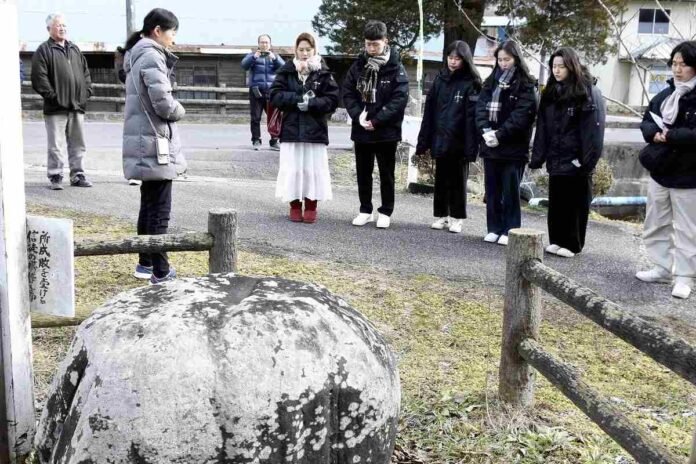Pilgrimage participants listen to explanations about the Jizo-no-Tsuji execution site in Ichinoseki, Iwate Prefecture on February 2.
6:00 JST, May 2, 2024
The stories of Christian martyrs in the Edo period (1603-1867) are being shared by residents of Okago District in Ichinoseki, Iwate Prefecture, in an effort to preserve their history and attract more visitors to the area.
It is believed that more than 300 Japanese Christians were executed in the district during the Edo period. There are many historical sites in the area related to martyrdom, such as the Okago Christian Martyrdom Memorial Park.
Last year, more than 700 tourists, mainly from South Korea, visited the district.
Residents in the neighborhood who work for the project want to preserve knowledge of the tragic history. One said they “want to make this a pilgrimage site in Japan, after Nagasaki.”
Kazuya Hatakeyama, head of Okago Kirishitan Shiseki Hozonkai (Okago District Historical Sites Preservation Association), told visitors in February: “Here at the Jizo-no-Tsuji site, about 180 martyrs were killed. It is said that the nearby Futamata River was stained red with blood.” The name of the association uses the word Kirishitan, an old Japanese word for Christians.
Hatakeyama, 76, spoke through an interpreter to 10 Christian students and adults from Pohang, South Korea.
According to the association, a traditional steelmaking process called tatara seitetsu once flourished in Okago District. In the Eiroku era (1558-1570), two brothers who were tatara seitetsu smiths were brought in from what is now Okayama Prefecture.
The brothers were Christians and their conversion efforts spread the religion among the residents.
But persecution of the faith escalated in the aftermath of the 1637 Shimabara Rebellion in Kyushu. In Okago District, 309 Christians were reportedly executed for their faith, the largest number in the Tohoku region.
To preserve the history of local Christian martyrs, the memorial park was built in 1996 by the city government of the then city of Fujisawa, now part of Ichinoseki. Various related facilities have been built in the park, including an archive museum and a church.
Several historical sites remain around the park that tell the story of the brutal persecutions of the Edo period. These include the Jizo-no-Tsuji and Daitenba execution sites, where people were forced to stamp on Christianity-related pictures to prove they were not Christians.
The pilgrimage began in 2019 after the Miyagi Prefecture government summoned a South Korean travel agency to conduct a tour. The prefecture also has Christianity-related historical sites, and more than 20% of South Korea’s population is said to be Christian.
South Korean churches and other entities planned tours where participants will visit the memorial park and other historical sites in Sendai and Tome in Miyagi Prefecture.
In February this year, visitors from South Korea had the opportunity to deepen ties with association members in Okago District by serving them Korean dishes.
Kim Soohong, a 44-year-old preacher in Pohang who led the South Korean travelers, said: “Although this place is small, the locals gave us a warm welcome. I want to visit this place again and again.”
The pastor said the district has a different appeal than “Hidden Christian Sites in the Nagasaki Region” on the UNESCO World Heritage List, which includes sites in Nagasaki Prefecture and the Amakusa Region of Kumamoto Prefecture.
This fiscal year, the association plans to build accommodation facilities for travelers, using materials used for temporary housing in areas devastated by the Great East Japan Earthquake.
Hatakeyama said: “We want to pass on the history of Okago District, which was also called the Shimabara of Michinoku Districts. [the Tohoku region]and at the same time promote the attractiveness of the region.”



